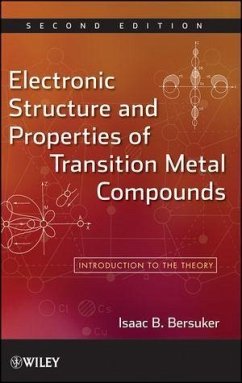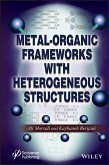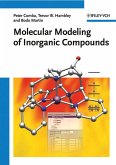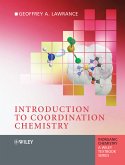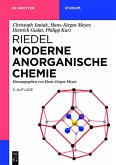Isaac B. Bersuker
Electronic Structure and Properties of Transition Metal Compounds (eBook, ePUB)
Introduction to the Theory
178,99 €
178,99 €
inkl. MwSt.
Sofort per Download lieferbar

0 °P sammeln
178,99 €
Als Download kaufen

178,99 €
inkl. MwSt.
Sofort per Download lieferbar

0 °P sammeln
Jetzt verschenken
Alle Infos zum eBook verschenken
178,99 €
inkl. MwSt.
Sofort per Download lieferbar
Alle Infos zum eBook verschenken

0 °P sammeln
Isaac B. Bersuker
Electronic Structure and Properties of Transition Metal Compounds (eBook, ePUB)
Introduction to the Theory
- Format: ePub
- Merkliste
- Auf die Merkliste
- Bewerten Bewerten
- Teilen
- Produkt teilen
- Produkterinnerung
- Produkterinnerung

Bitte loggen Sie sich zunächst in Ihr Kundenkonto ein oder registrieren Sie sich bei
bücher.de, um das eBook-Abo tolino select nutzen zu können.
Hier können Sie sich einloggen
Hier können Sie sich einloggen
Sie sind bereits eingeloggt. Klicken Sie auf 2. tolino select Abo, um fortzufahren.

Bitte loggen Sie sich zunächst in Ihr Kundenkonto ein oder registrieren Sie sich bei bücher.de, um das eBook-Abo tolino select nutzen zu können.
With more than 40% new and revised materials, this second edition offers researchers and students in the field a comprehensive understanding of fundamental molecular properties amidst cutting-edge applications. Including ~70 Example-Boxes and summary notes, questions, exercises, problem sets, and illustrations in each chapter, this publication is also suitable for use as a textbook for advanced undergraduate and graduate students. Novel material is introduced in description of multi-orbital chemical bonding, spectroscopic and magnetic properties, methods of electronic structure calculation,…mehr
- Geräte: eReader
- ohne Kopierschutz
- eBook Hilfe
Andere Kunden interessierten sich auch für
![Electronic Structure and Properties of Transition Metal Compounds (eBook, PDF) Electronic Structure and Properties of Transition Metal Compounds (eBook, PDF)]() Isaac B. BersukerElectronic Structure and Properties of Transition Metal Compounds (eBook, PDF)178,99 €
Isaac B. BersukerElectronic Structure and Properties of Transition Metal Compounds (eBook, PDF)178,99 €![Metal-Organic Frameworks with Heterogeneous Structures (eBook, ePUB) Metal-Organic Frameworks with Heterogeneous Structures (eBook, ePUB)]() Metal-Organic Frameworks with Heterogeneous Structures (eBook, ePUB)164,99 €
Metal-Organic Frameworks with Heterogeneous Structures (eBook, ePUB)164,99 €![Molecular Modeling of Inorganic Compounds (eBook, PDF) Molecular Modeling of Inorganic Compounds (eBook, PDF)]() Peter CombaMolecular Modeling of Inorganic Compounds (eBook, PDF)183,99 €
Peter CombaMolecular Modeling of Inorganic Compounds (eBook, PDF)183,99 €![Hypercarbon Chemistry (eBook, ePUB) Hypercarbon Chemistry (eBook, ePUB)]() George A. OlahHypercarbon Chemistry (eBook, ePUB)127,99 €
George A. OlahHypercarbon Chemistry (eBook, ePUB)127,99 €![Introduction to Coordination Chemistry (eBook, ePUB) Introduction to Coordination Chemistry (eBook, ePUB)]() Geoffrey Alan LawranceIntroduction to Coordination Chemistry (eBook, ePUB)42,99 €
Geoffrey Alan LawranceIntroduction to Coordination Chemistry (eBook, ePUB)42,99 €![Ligand Design in Metal Chemistry (eBook, ePUB) Ligand Design in Metal Chemistry (eBook, ePUB)]() Ligand Design in Metal Chemistry (eBook, ePUB)134,99 €
Ligand Design in Metal Chemistry (eBook, ePUB)134,99 €![Riedel Moderne Anorganische Chemie (eBook, ePUB) Riedel Moderne Anorganische Chemie (eBook, ePUB)]() Christoph JaniakRiedel Moderne Anorganische Chemie (eBook, ePUB)79,95 €
Christoph JaniakRiedel Moderne Anorganische Chemie (eBook, ePUB)79,95 €-
-
-
With more than 40% new and revised materials, this second edition offers researchers and students in the field a comprehensive understanding of fundamental molecular properties amidst cutting-edge applications. Including ~70 Example-Boxes and summary notes, questions, exercises, problem sets, and illustrations in each chapter, this publication is also suitable for use as a textbook for advanced undergraduate and graduate students. Novel material is introduced in description of multi-orbital chemical bonding, spectroscopic and magnetic properties, methods of electronic structure calculation, and quantum-classical modeling for organometallic and metallobiochemical systems. This is an excellent reference for chemists, researchers and teachers, and advanced undergraduate and graduate students in inorganic, coordination, and organometallic chemistry.
Dieser Download kann aus rechtlichen Gründen nur mit Rechnungsadresse in D ausgeliefert werden.
Produktdetails
- Produktdetails
- Verlag: John Wiley & Sons
- Erscheinungstermin: 1. Dezember 2010
- Englisch
- ISBN-13: 9780470920855
- Artikelnr.: 37300447
- Verlag: John Wiley & Sons
- Erscheinungstermin: 1. Dezember 2010
- Englisch
- ISBN-13: 9780470920855
- Artikelnr.: 37300447
- Herstellerkennzeichnung Die Herstellerinformationen sind derzeit nicht verfügbar.
Isaac B. Bersuker, PhD, DSc, is a Senior Research Scientist and Adjunct Professor of Theoretical Chemistry at the University of Texas at Austin. He is a member of the Academy of Sciences of Moldova (former USSR) and the recipient of numerous awards, including the Medal of Honor (Republic of Moldova), David Ben-Gurion Medal (Be'er Sheva University), Chugaev Medal (Russian Academy of Sciences), and the 1979 State Prize Laureate (USSR).
Preface.
Foreword to the First Edition.
Mathematical Symbols.
Abbreviations.
1 Introduction: Subject and Methods.
1.1 Objectives.
1.2 Definitions of Chemical Bonding and Transition Metal Coordination
System.
1.3 The Schrödinger Equation.
Summary Notes.
References.
2 Atomic States.
2.1 One-Electron States.
2.2 Multielectron States: Energy Terms.
Summary Notes.
Questions.
Exercises and Problems.
References.
3 Symmetry Ideas and Group-Theoretical Description.
3.1 Symmetry Transformations and Matrices.
3.2 Groups of Symmetry Transformations.
3.3 Representations of Groups and Matrices of Representations.
3.4 Classification of Molecular Terms and Vibrations, Selection Rules, and
Wigner-Eckart Theorem.
3.5 Construction of Symmetrized Molecular Orbitals and Normal Vibrations.
3.6 The Notion of Double Groups.
Summary Notes.
Exercises.
References.
4 Crystal Field Theory.
4.1 Introduction.
4.2 Splitting of the Energy Levels of One d Electron in Ligand Fields.
4.3 Several d Electrons.
4.4 f -Electron Term Splitting.
4.5 Crystal Field Parameters and Extrastabilization Energy.
4.6 Limits of Applicability of Crystal Field Theory.
Summary Notes.
Questions.
Exercises and Problems.
References.
5 Method of Molecular Orbitals and Related Approaches.
5.1 Basic Ideas of the MO LCAO Method.
5.2 Charge Distribution and Bonding in the MO LCAO Method and the Case of
Weak Covalency.
5.3 Methods of Calculation of MO Energies and LCAO Coefficients.
5.4 Semiquantitative Approaches.
5.5 Semiempirical Methods.
5.6 Fragmentary Calculations, Molecular Mechanics, and Combined
Quantum/Classical (QM/MM) Modeling.
5.7 General Comparison of Methods.
Summary Notes.
Exercises and Problems.
References.
6 Electronic Structure and Chemical Bonding.
6.1 Classification of Chemical Bonds by Electronic Structure and Role of d
and f Electrons in Coordination Bonding.
6.2 Qualitative Aspects and Electronic Configurations.
6.3 Ligand Bonding.
6.4 Energies, Geometries, and Charge Distributions.
6.5 Relativistic Effects.
Summary Notes.
Exercises and Problems.
References.
7 Electronic Control of Molecular Shapes and Transformations via Vibronic
Coupling.
7.1 Molecular Vibrations.
7.2 Vibronic Coupling.
7.3 The Jahn-Teller Effect.
7.4 Pseudo-Jahn-Teller Effect and the Two-Level Paradigm.
Summary Notes.
Exercises and Problems.
References.
8 Electronic Structure Investigated by Physical Methods.
8.1 Band Shapes of Electronic Spectra.
8.2 d -d, Charge Transfer, Infrared, and Raman Spectra.
8.3 X-Ray and Ultraviolet Photoelectron Spectra; EXAFS.
8.4 Magnetic Properties.
8.5 Gamma-Resonance Spectroscopy.
8.6 Electron Charge and Spin Density Distribution in Diffraction Methods.
Summary Notes.
Exercises and Problems.
References.
9 Stereochemistry and Crystal Chemistry.
9.1 Definitions. Semiclassical Approaches.
9.2 Vibronic Effects in Stereochemistry.
9.3 Mutual Influence of Ligands.
9.4 Crystal Stereochemistry.
Summary Notes.
Exercises and Problems.
References.
10 Electron Transfer, Redox Properties, and Electron-Conformational
Effects.
10.1 Electron Transfer and Charge Transfer by Coordination.
10.2 Electron Transfer in Mixed-Valence Compounds.
10.3 Electron-Conformational Effects in Biological Systems.
Summary Notes.
Exercises and Problems.
References.
11 Reactivity and Catalytic Action.
11.1 Electronic Factors in Reactivity.
11.2 Electronic Control of Chemical Activation via Vibronic Coupling.
11.3 Direct Computation of Energy Barriers of Chemical Reactions.
Summary Notes.
Questions and Problems.
References.
Appendixes.
Answers and Solutions.
Subject Index.
Formula Index.
Foreword to the First Edition.
Mathematical Symbols.
Abbreviations.
1 Introduction: Subject and Methods.
1.1 Objectives.
1.2 Definitions of Chemical Bonding and Transition Metal Coordination
System.
1.3 The Schrödinger Equation.
Summary Notes.
References.
2 Atomic States.
2.1 One-Electron States.
2.2 Multielectron States: Energy Terms.
Summary Notes.
Questions.
Exercises and Problems.
References.
3 Symmetry Ideas and Group-Theoretical Description.
3.1 Symmetry Transformations and Matrices.
3.2 Groups of Symmetry Transformations.
3.3 Representations of Groups and Matrices of Representations.
3.4 Classification of Molecular Terms and Vibrations, Selection Rules, and
Wigner-Eckart Theorem.
3.5 Construction of Symmetrized Molecular Orbitals and Normal Vibrations.
3.6 The Notion of Double Groups.
Summary Notes.
Exercises.
References.
4 Crystal Field Theory.
4.1 Introduction.
4.2 Splitting of the Energy Levels of One d Electron in Ligand Fields.
4.3 Several d Electrons.
4.4 f -Electron Term Splitting.
4.5 Crystal Field Parameters and Extrastabilization Energy.
4.6 Limits of Applicability of Crystal Field Theory.
Summary Notes.
Questions.
Exercises and Problems.
References.
5 Method of Molecular Orbitals and Related Approaches.
5.1 Basic Ideas of the MO LCAO Method.
5.2 Charge Distribution and Bonding in the MO LCAO Method and the Case of
Weak Covalency.
5.3 Methods of Calculation of MO Energies and LCAO Coefficients.
5.4 Semiquantitative Approaches.
5.5 Semiempirical Methods.
5.6 Fragmentary Calculations, Molecular Mechanics, and Combined
Quantum/Classical (QM/MM) Modeling.
5.7 General Comparison of Methods.
Summary Notes.
Exercises and Problems.
References.
6 Electronic Structure and Chemical Bonding.
6.1 Classification of Chemical Bonds by Electronic Structure and Role of d
and f Electrons in Coordination Bonding.
6.2 Qualitative Aspects and Electronic Configurations.
6.3 Ligand Bonding.
6.4 Energies, Geometries, and Charge Distributions.
6.5 Relativistic Effects.
Summary Notes.
Exercises and Problems.
References.
7 Electronic Control of Molecular Shapes and Transformations via Vibronic
Coupling.
7.1 Molecular Vibrations.
7.2 Vibronic Coupling.
7.3 The Jahn-Teller Effect.
7.4 Pseudo-Jahn-Teller Effect and the Two-Level Paradigm.
Summary Notes.
Exercises and Problems.
References.
8 Electronic Structure Investigated by Physical Methods.
8.1 Band Shapes of Electronic Spectra.
8.2 d -d, Charge Transfer, Infrared, and Raman Spectra.
8.3 X-Ray and Ultraviolet Photoelectron Spectra; EXAFS.
8.4 Magnetic Properties.
8.5 Gamma-Resonance Spectroscopy.
8.6 Electron Charge and Spin Density Distribution in Diffraction Methods.
Summary Notes.
Exercises and Problems.
References.
9 Stereochemistry and Crystal Chemistry.
9.1 Definitions. Semiclassical Approaches.
9.2 Vibronic Effects in Stereochemistry.
9.3 Mutual Influence of Ligands.
9.4 Crystal Stereochemistry.
Summary Notes.
Exercises and Problems.
References.
10 Electron Transfer, Redox Properties, and Electron-Conformational
Effects.
10.1 Electron Transfer and Charge Transfer by Coordination.
10.2 Electron Transfer in Mixed-Valence Compounds.
10.3 Electron-Conformational Effects in Biological Systems.
Summary Notes.
Exercises and Problems.
References.
11 Reactivity and Catalytic Action.
11.1 Electronic Factors in Reactivity.
11.2 Electronic Control of Chemical Activation via Vibronic Coupling.
11.3 Direct Computation of Energy Barriers of Chemical Reactions.
Summary Notes.
Questions and Problems.
References.
Appendixes.
Answers and Solutions.
Subject Index.
Formula Index.
Preface.
Foreword to the First Edition.
Mathematical Symbols.
Abbreviations.
1 Introduction: Subject and Methods.
1.1 Objectives.
1.2 Definitions of Chemical Bonding and Transition Metal Coordination
System.
1.3 The Schrödinger Equation.
Summary Notes.
References.
2 Atomic States.
2.1 One-Electron States.
2.2 Multielectron States: Energy Terms.
Summary Notes.
Questions.
Exercises and Problems.
References.
3 Symmetry Ideas and Group-Theoretical Description.
3.1 Symmetry Transformations and Matrices.
3.2 Groups of Symmetry Transformations.
3.3 Representations of Groups and Matrices of Representations.
3.4 Classification of Molecular Terms and Vibrations, Selection Rules, and
Wigner-Eckart Theorem.
3.5 Construction of Symmetrized Molecular Orbitals and Normal Vibrations.
3.6 The Notion of Double Groups.
Summary Notes.
Exercises.
References.
4 Crystal Field Theory.
4.1 Introduction.
4.2 Splitting of the Energy Levels of One d Electron in Ligand Fields.
4.3 Several d Electrons.
4.4 f -Electron Term Splitting.
4.5 Crystal Field Parameters and Extrastabilization Energy.
4.6 Limits of Applicability of Crystal Field Theory.
Summary Notes.
Questions.
Exercises and Problems.
References.
5 Method of Molecular Orbitals and Related Approaches.
5.1 Basic Ideas of the MO LCAO Method.
5.2 Charge Distribution and Bonding in the MO LCAO Method and the Case of
Weak Covalency.
5.3 Methods of Calculation of MO Energies and LCAO Coefficients.
5.4 Semiquantitative Approaches.
5.5 Semiempirical Methods.
5.6 Fragmentary Calculations, Molecular Mechanics, and Combined
Quantum/Classical (QM/MM) Modeling.
5.7 General Comparison of Methods.
Summary Notes.
Exercises and Problems.
References.
6 Electronic Structure and Chemical Bonding.
6.1 Classification of Chemical Bonds by Electronic Structure and Role of d
and f Electrons in Coordination Bonding.
6.2 Qualitative Aspects and Electronic Configurations.
6.3 Ligand Bonding.
6.4 Energies, Geometries, and Charge Distributions.
6.5 Relativistic Effects.
Summary Notes.
Exercises and Problems.
References.
7 Electronic Control of Molecular Shapes and Transformations via Vibronic
Coupling.
7.1 Molecular Vibrations.
7.2 Vibronic Coupling.
7.3 The Jahn-Teller Effect.
7.4 Pseudo-Jahn-Teller Effect and the Two-Level Paradigm.
Summary Notes.
Exercises and Problems.
References.
8 Electronic Structure Investigated by Physical Methods.
8.1 Band Shapes of Electronic Spectra.
8.2 d -d, Charge Transfer, Infrared, and Raman Spectra.
8.3 X-Ray and Ultraviolet Photoelectron Spectra; EXAFS.
8.4 Magnetic Properties.
8.5 Gamma-Resonance Spectroscopy.
8.6 Electron Charge and Spin Density Distribution in Diffraction Methods.
Summary Notes.
Exercises and Problems.
References.
9 Stereochemistry and Crystal Chemistry.
9.1 Definitions. Semiclassical Approaches.
9.2 Vibronic Effects in Stereochemistry.
9.3 Mutual Influence of Ligands.
9.4 Crystal Stereochemistry.
Summary Notes.
Exercises and Problems.
References.
10 Electron Transfer, Redox Properties, and Electron-Conformational
Effects.
10.1 Electron Transfer and Charge Transfer by Coordination.
10.2 Electron Transfer in Mixed-Valence Compounds.
10.3 Electron-Conformational Effects in Biological Systems.
Summary Notes.
Exercises and Problems.
References.
11 Reactivity and Catalytic Action.
11.1 Electronic Factors in Reactivity.
11.2 Electronic Control of Chemical Activation via Vibronic Coupling.
11.3 Direct Computation of Energy Barriers of Chemical Reactions.
Summary Notes.
Questions and Problems.
References.
Appendixes.
Answers and Solutions.
Subject Index.
Formula Index.
Foreword to the First Edition.
Mathematical Symbols.
Abbreviations.
1 Introduction: Subject and Methods.
1.1 Objectives.
1.2 Definitions of Chemical Bonding and Transition Metal Coordination
System.
1.3 The Schrödinger Equation.
Summary Notes.
References.
2 Atomic States.
2.1 One-Electron States.
2.2 Multielectron States: Energy Terms.
Summary Notes.
Questions.
Exercises and Problems.
References.
3 Symmetry Ideas and Group-Theoretical Description.
3.1 Symmetry Transformations and Matrices.
3.2 Groups of Symmetry Transformations.
3.3 Representations of Groups and Matrices of Representations.
3.4 Classification of Molecular Terms and Vibrations, Selection Rules, and
Wigner-Eckart Theorem.
3.5 Construction of Symmetrized Molecular Orbitals and Normal Vibrations.
3.6 The Notion of Double Groups.
Summary Notes.
Exercises.
References.
4 Crystal Field Theory.
4.1 Introduction.
4.2 Splitting of the Energy Levels of One d Electron in Ligand Fields.
4.3 Several d Electrons.
4.4 f -Electron Term Splitting.
4.5 Crystal Field Parameters and Extrastabilization Energy.
4.6 Limits of Applicability of Crystal Field Theory.
Summary Notes.
Questions.
Exercises and Problems.
References.
5 Method of Molecular Orbitals and Related Approaches.
5.1 Basic Ideas of the MO LCAO Method.
5.2 Charge Distribution and Bonding in the MO LCAO Method and the Case of
Weak Covalency.
5.3 Methods of Calculation of MO Energies and LCAO Coefficients.
5.4 Semiquantitative Approaches.
5.5 Semiempirical Methods.
5.6 Fragmentary Calculations, Molecular Mechanics, and Combined
Quantum/Classical (QM/MM) Modeling.
5.7 General Comparison of Methods.
Summary Notes.
Exercises and Problems.
References.
6 Electronic Structure and Chemical Bonding.
6.1 Classification of Chemical Bonds by Electronic Structure and Role of d
and f Electrons in Coordination Bonding.
6.2 Qualitative Aspects and Electronic Configurations.
6.3 Ligand Bonding.
6.4 Energies, Geometries, and Charge Distributions.
6.5 Relativistic Effects.
Summary Notes.
Exercises and Problems.
References.
7 Electronic Control of Molecular Shapes and Transformations via Vibronic
Coupling.
7.1 Molecular Vibrations.
7.2 Vibronic Coupling.
7.3 The Jahn-Teller Effect.
7.4 Pseudo-Jahn-Teller Effect and the Two-Level Paradigm.
Summary Notes.
Exercises and Problems.
References.
8 Electronic Structure Investigated by Physical Methods.
8.1 Band Shapes of Electronic Spectra.
8.2 d -d, Charge Transfer, Infrared, and Raman Spectra.
8.3 X-Ray and Ultraviolet Photoelectron Spectra; EXAFS.
8.4 Magnetic Properties.
8.5 Gamma-Resonance Spectroscopy.
8.6 Electron Charge and Spin Density Distribution in Diffraction Methods.
Summary Notes.
Exercises and Problems.
References.
9 Stereochemistry and Crystal Chemistry.
9.1 Definitions. Semiclassical Approaches.
9.2 Vibronic Effects in Stereochemistry.
9.3 Mutual Influence of Ligands.
9.4 Crystal Stereochemistry.
Summary Notes.
Exercises and Problems.
References.
10 Electron Transfer, Redox Properties, and Electron-Conformational
Effects.
10.1 Electron Transfer and Charge Transfer by Coordination.
10.2 Electron Transfer in Mixed-Valence Compounds.
10.3 Electron-Conformational Effects in Biological Systems.
Summary Notes.
Exercises and Problems.
References.
11 Reactivity and Catalytic Action.
11.1 Electronic Factors in Reactivity.
11.2 Electronic Control of Chemical Activation via Vibronic Coupling.
11.3 Direct Computation of Energy Barriers of Chemical Reactions.
Summary Notes.
Questions and Problems.
References.
Appendixes.
Answers and Solutions.
Subject Index.
Formula Index.
